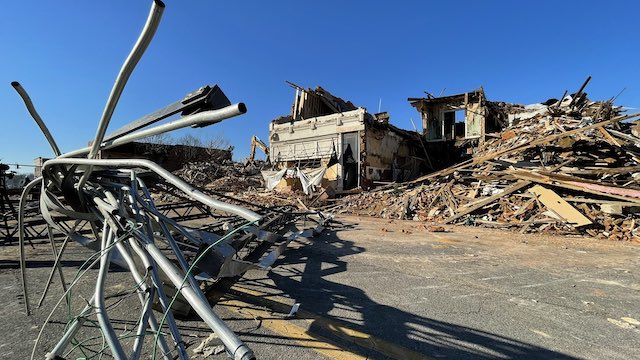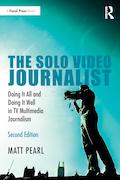I’m not sure what I expected.
Did I expect, a month after tornadoes that ravaged towns across four states, everything to have magically recovered? Of course not.
Did I expect, upon arriving in Mayfield, Ky. – the town that suffered the most damage and received the most attention – to see throngs of camera crews and reporters? Not necessarily.
I didn’t expect miracles, nor did I expect the eyes of the world to remain fixed on these few towns. I guess I expected what I ended up seeing: slight progress, continued emotional toll, and few journalists to witness the damage and potentially redirect the spotlight back to communities that could use it.
But I was definitely still thrown off by it.
I covered the tornadoes when they happened – or, more specifically, the day after. I drove with a photojournalist to Mayfield and found destruction of a magnitude that’s hard to truly comprehend. We were humbled throughout: by the buildings and homes irrevocably damaged; by the residents who still seemed somewhat in shock, and by the knowledge that recovery – where it happens – will likely require years.
That entire time, we were never alone. Every corner we turned, we saw fellow journalists. Some drove from local stations in Kentucky. Others arrived from Nashville. Many were, like us, national crews, sent to parachute into town, tell stories, and depart. I was in Mayfield for a day. Then I drove to Nashville and flew to my next assignment in Philadelphia.
I always appreciated our purpose there. We came to Mayfield not to sensationalize but to humanize. We approached individuals with empathy and respect, and we tried not to intrude or overstep in any way. Stories meant attention. Maybe a person would see it and donate to a recovery fund, volunteer to help, or maybe even just reach out to someone they know who might be affected.
Inevitably, the news cycle moved on. Within days, the tornado damage was replaced by coverage of politics, the rising Omicron variant, and the many other stories that felt more immediate – and, often, just as important.
It all makes sense.
But it doesn’t make the experience any less jarring when, a month later, all the attention is gone.
This time, we went to a pair of towns roughly an hour apart: Mayfield and Dawson Springs. In both, we saw a few signs of life. Schools in Dawson Springs will reopen later this month. The town’s main restaurant reopened last week. A church is being used to coordinate volunteer efforts. And we did see volunteers from various states, working hard to keep spirits somewhat high.
Mostly, I saw people unsure of whether to try to rebuild or to move elsewhere. That’s a tremendously weighty decision for anyone, let alone someone who’s lived in the same town for decades. I interviewed people facing seemingly impossible choices and forced to potentially sever connections with communities they hold dear.
I’m fortunate my manager championed the idea of going back to Kentucky a month later, and I was more than willing to accept the assignment. I’ve done several stories like this over the years. Each time, I’m reminded of the complex and powerful toll that never really goes away.
I’m also reminded of how the outside world’s attention goes away far too quickly.
The Solo Video Journalist is available for purchase. You can find it on Amazon, Barnes & Noble, and the publisher’s web site.
Matt Pearl is the author of the Telling the Story blog and podcast. Feel free to comment below or e-mail Matt at matt@tellingthestoryblog.com. You can also follow Matt on Facebook, Twitter, and his web site, mattpearl.tv.

